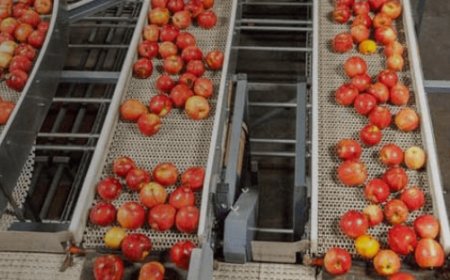How to Find Crispy Tostadas in Fort Worth
How to Find Crispy Tostadas in Fort Worth Fort Worth, Texas, is a city where tradition meets innovation on every corner—and nowhere is that more deliciously evident than in its vibrant Mexican and Tex-Mex food scene. Among the most beloved staples of this culinary landscape are crispy tostadas: golden, crunchy tortillas topped with savory beans, fresh vegetables, tender meats, and zesty salsas. Bu
How to Find Crispy Tostadas in Fort Worth
Fort Worth, Texas, is a city where tradition meets innovation on every corner—and nowhere is that more deliciously evident than in its vibrant Mexican and Tex-Mex food scene. Among the most beloved staples of this culinary landscape are crispy tostadas: golden, crunchy tortillas topped with savory beans, fresh vegetables, tender meats, and zesty salsas. But for visitors and even longtime residents, finding the *perfect* crispy tostada—crisp enough to hold its structure without crumbling, flavorful without being overwhelming, and made with fresh, high-quality ingredients—can feel like a treasure hunt. This guide is your definitive roadmap to discovering the finest crispy tostadas in Fort Worth, whether you’re seeking a quick lunch, a family dinner, or an authentic culinary experience rooted in regional heritage.
Understanding how to identify and locate truly exceptional crispy tostadas isn’t just about knowing where to go—it’s about recognizing the hallmarks of quality, understanding the cultural context, and knowing what to look for beyond the menu board. This tutorial walks you through every step of the process, from research and local insights to on-the-ground evaluation techniques. By the end, you’ll not only know where to find the best tostadas in town, but you’ll also be equipped to judge them like a seasoned food critic.
Step-by-Step Guide
Step 1: Define What Makes a Tostada “Crispy”
Before you begin your search, you must understand what distinguishes a truly crispy tostada from a soggy or undercooked version. A high-quality crispy tostada should have:
- A uniformly golden-brown exterior with no pale or burnt spots
- A firm, audible crunch when bitten into—no softness or sponginess
- Light oiliness, not greasiness, indicating proper frying technique
- A neutral, slightly toasted corn flavor that complements, not overpowers, the toppings
Many restaurants use pre-fried tostada shells for convenience, but the best establishments fry theirs fresh to order. This ensures maximum crispness and prevents moisture absorption from toppings. Look for signs of on-site frying: an open kitchen, the smell of warm corn oil, or staff handling tortillas in a fryer.
Step 2: Research Local Favorites Using Trusted Sources
Start your search with credible, locally focused food resources. Avoid generic “top 10” lists from national outlets that may not reflect Fort Worth’s nuanced food culture. Instead, prioritize:
- Fort Worth Weekly’s Food Section – A long-standing local publication with deep ties to the city’s culinary community. Their annual “Best of Fort Worth” issue often highlights standout tostada spots.
- Yelp and Google Maps reviews – Filter by “most recent” and look for consistent mentions of “crispy,” “freshly fried,” or “perfect crunch.” Pay attention to photos uploaded by users—real images of the tostada’s texture are invaluable.
- Local food bloggers – Follow creators like @FortWorthEats or @TacoTrailTX on Instagram. They often post unfiltered, on-the-ground reviews with detailed descriptions of texture and preparation.
- Reddit’s r/FortWorth – Search for threads like “Best tostadas in FW?” or “Where do locals go for crispy tostadas?” These often yield authentic, unfiltered recommendations.
When reviewing online content, look for patterns. If three different sources independently recommend the same spot for its “crisp-to-the-last-bite” tostadas, that’s a strong signal.
Step 3: Prioritize Family-Owned and Mexican-Owned Establishments
Authentic crispy tostadas are often rooted in generations of family recipes passed down through Mexican and Tejano households. While chain restaurants may offer tostadas, they rarely achieve the depth of flavor or texture found in independent, family-run spots.
Look for businesses with:
- Signs in Spanish or bilingual menus
- Names that reflect regional Mexican heritage (e.g., “Casa de la Tostada,” “Tostadas El Charro,” “La Cocina de Abuela”)
- Staff who speak Spanish as a primary language
- Simple, unpolished interiors with handwritten specials on chalkboards
These are not indicators of “lack of professionalism”—they’re signs of authenticity. Family-run kitchens prioritize tradition over trend, and their tostadas are typically fried in small batches with care.
Step 4: Visit During Peak Lunch Hours
Timing matters. The best crispy tostadas are made fresh to order, and restaurants that take pride in their craft often prepare them in small batches throughout the day. Visiting during lunch (11:30 a.m.–2:00 p.m.) ensures:
- Freshly fried shells are being produced
- Staff are fully staffed and focused on food quality
- There’s a steady flow of regular customers—proof of consistent quality
Avoid visiting right before closing or during slow mid-afternoon hours. Tostadas sitting under heat lamps for hours become limp and lose their signature crunch. If you see a tostada sitting under a heat lamp for more than 15 minutes, ask if it’s made fresh or pre-fried.
Step 5: Observe the Preparation Process
If possible, position yourself near the kitchen or ask if you can watch the tostada being made. A properly prepared tostada involves:
- Hand-pressed corn tortillas (never flour)
- Frying in vegetable or corn oil at 350–375°F for 30–45 seconds per side
- Draining on paper towels, not in a basket
- Immediate plating with toppings added just before serving
Watch for the sound: a properly fried tostada should make a sharp, dry “snap” when broken. If it bends or squeaks, it’s undercooked. If it’s dark brown or smoky, it’s overdone. The ideal color is a warm, even gold—like toasted sesame seeds.
Step 6: Evaluate the Toppings and Balance
A crispy tostada is only as good as its toppings. The shell is the foundation, but the balance of flavors and textures elevates it from good to unforgettable. Look for:
- Refried beans – Smooth, not grainy, seasoned with garlic and lard or vegetable oil
- Protein – Shredded chicken, carnitas, or beef brisket that’s tender but not mushy
- Vegetables – Shredded lettuce, diced tomato, and red onion that are fresh, not wilted
- Salsa – A bright, acidic salsa verde or roasted tomato salsa that cuts through the richness
- Cheese – Crumbled queso fresco or cotija, not processed shredded cheese
- Optional garnishes – A drizzle of crema, avocado slices, or pickled jalapeños
Too many toppings can overwhelm the shell and cause it to soften prematurely. The best tostadas strike a balance: generous, but not overloaded.
Step 7: Ask Locals for Hidden Gems
Some of the best tostadas in Fort Worth are found in unassuming locations: a small taqueria tucked behind a gas station, a food truck parked near a park, or a kitchen operating out of a home with a “Abierta” sign in the window.
To uncover these hidden spots:
- Ask your hotel concierge or Airbnb host: “Where do *you* go for the crispiest tostadas?”
- Strike up a conversation with a local at a farmers’ market or community event
- Visit Mexican grocery stores like Mercado de México or La Tiendita—ask the clerks where they buy their tostadas
- Check community bulletin boards in churches, libraries, or laundromats—many family-run operations advertise there
These sources often lead to places that don’t have a social media presence but have decades of loyal customers.
Step 8: Taste and Compare
Don’t settle for the first tostada you try. Visit at least three different spots within a single week. Take notes on:
- Crispness (rate 1–10)
- Flavor balance
- Texture of toppings
- Value for price
- Overall experience
For example, one spot might have a perfectly fried shell but use bland beans. Another might have incredible carnitas but a soggy base. The ideal tostada excels in all areas. Keep a personal scorecard—this will help you identify patterns and make informed decisions.
Step 9: Return and Build Relationships
Once you find a standout spot, return multiple times. Build rapport with the staff. Learn the name of the person who makes the tostadas. Ask questions: “Do you fry these fresh every time?” “What kind of corn do you use?”
Regular customers often receive special treatment—extra toppings, a second salsa, or even a recipe tip. In Fort Worth’s tight-knit food community, loyalty is rewarded.
Step 10: Share Your Findings Responsibly
When you discover an exceptional tostada spot, share it—but do so thoughtfully. Leave a detailed review on Google or Yelp mentioning specific details: “The tostada was fried right in front of me, and the crunch lasted through all six bites.”
Avoid overhyping or exaggerating. Authenticity matters more than viral fame. Your honest, thoughtful review helps others find real quality, not just popularity.
Best Practices
1. Prioritize Freshness Over Convenience
Never choose a tostada that’s been sitting under a heat lamp. Even the most beautifully plated tostada loses its integrity after 20 minutes. If a restaurant doesn’t offer to make it fresh, move on.
2. Avoid “Tostada Bars” with Pre-Packaged Shells
Some establishments market themselves as “tostada bars,” offering a build-your-own experience with pre-fried shells. While convenient, these rarely match the quality of hand-fried versions. The shells are often stale, brittle, or overly oily.
3. Understand Regional Variations
Fort Worth’s tostadas reflect influences from multiple Mexican states. In the north, you’ll find tostadas with beef or chorizo. In the south, seafood tostadas (with shrimp or ceviche) are common. Ask for the “house specialty” to experience the restaurant’s regional roots.
4. Be Mindful of Dietary Preferences
Many traditional tostadas use lard in the beans or frying oil. If you’re vegetarian, vegan, or avoiding pork, ask specifically: “Is the oil vegetable-based?” and “Are the beans cooked with lard?” Reputable kitchens will accommodate these requests without hesitation.
5. Don’t Judge by Ambiance
The most authentic tostadas are often served on paper plates with plastic utensils. A clean, well-maintained space matters—but a fancy interior doesn’t guarantee quality. Judge the food, not the decor.
6. Learn Basic Spanish Phrases
Knowing simple phrases like “¿Están hechos frescos?” (Are they made fresh?) or “¿Cuál es la más crujiente?” (Which is the crispiest?) shows respect and often leads to better service and insider tips.
7. Visit in Different Seasons
Some restaurants change their menus seasonally. In summer, you might find tostadas with mango or jicama slaw. In winter, spicier salsas and heartier proteins dominate. Revisit your favorite spots throughout the year to experience their full range.
8. Support Local Ingredients
Look for restaurants that source tortillas from local corn mills or use produce from North Texas farms. These establishments often have a deeper commitment to quality and sustainability.
9. Avoid Tourist Traps
Be cautious of restaurants near major attractions like the Fort Worth Stockyards that market “authentic Mexican food” with English-only menus and cartoonish decor. These are often designed for tourists, not locals.
10. Document Your Journey
Keep a food journal or photo log of your tostada explorations. Note the date, location, price, and your impressions. Over time, you’ll develop a personal “to-do list” of top spots and understand your own preferences better.
Tools and Resources
Online Platforms
- Google Maps – Use filters for “open now,” “highly rated,” and “photo uploads.” Look for images tagged “tostada” with visible texture.
- Yelp – Sort reviews by “most recent” and scan for keywords: “crispy,” “fresh,” “crunch,” “not soggy.”
- Instagram – Search hashtags:
FortWorthTostadas, #TostadasFW, #TexasTacos. Follow local food influencers.
- OpenTable or Resy – Some upscale Mexican restaurants list tostadas as appetizers. Check their menus online before visiting.
Local Publications
- Fort Worth Weekly – Weekly food column and annual “Best of Fort Worth” issue
- Dallas Observer – Covers Fort Worth food scenes with depth and regional insight
- WFAA’s Food & Drink – Local TV segment featuring hidden gems
Community Resources
- Fort Worth Public Library – Offers free access to food and culture databases
- Local cultural centers – Such as the National Museum of Mexican Art (Fort Worth branch) often host food events
- University of North Texas (UNT) Culinary Club – Students often explore and review local cuisine
Mobile Apps
- Waze – Use to navigate to lesser-known locations with high ratings
- Splitwise or Foodie – Share tostada experiences with friends and compare notes
- Google Lens – Snap a photo of a tostada to identify ingredients or compare to other dishes
Books and Documentaries
- “Tacos: A Guide to the Best in Texas” by José R. Ralat – Includes Fort Worth spots with historical context
- “The Tex-Mex Cookbook” by Pati Jinich – Explains the science behind frying tortillas
- Documentary: “Taco Chronicles” (Netflix) – Episode on tostadas offers cultural background
Real Examples
Example 1: Tostadas El Charro – Near the Cultural District
Located in a small, unmarked building near the Fort Worth Cultural District, Tostadas El Charro has been run by the García family since 1987. Their tostadas are fried daily in corn oil, using corn masa from a mill in Monterrey. Customers consistently praise the “sound it makes when you bite into it.” The house specialty is the “Tostada de Pescado,” topped with fried tilapia, cabbage slaw, and a tangy lime crema. The shell holds up even after 10 minutes—rare for a seafood tostada.
Example 2: La Casa de la Tostada – Near the Stockyards
Despite its proximity to tourist-heavy areas, La Casa de la Tostada is a local favorite. The owner, María González, insists on frying each shell individually in small batches. Her secret? A touch of lard in the oil for flavor, and a 375°F fry temperature. The tostada comes with house-made refried black beans and a salsa roja made from roasted hatch chiles. Reviews mention the “perfect crunch that doesn’t break under the weight of the toppings.”
Example 3: Tostada Truck 17 – Near the Trinity River
This food truck, parked daily near the Trinity River trails, serves what many locals call “the crispiest tostada in North Texas.” The owner, Carlos, uses heirloom blue corn from a family farm in Oaxaca. His tostadas are fried in avocado oil and topped with slow-cooked brisket, pickled red onions, and a cilantro-lime crema. The truck doesn’t have a website, but its Instagram (@TostadaTruck17) is updated daily with photos of fresh batches. The tostada is $6.50 and comes with a free side of chiles rellenos.
Example 4: El Jefe’s Kitchen – South Fort Worth
A home-based operation with a “Abierta” sign in the driveway, El Jefe’s Kitchen is known for its “Tostada de Mole.” The shell is fried in peanut oil (a rare but traditional choice in some regions), then topped with a rich, dark mole sauce, shredded chicken, and toasted sesame seeds. The contrast between the crunchy shell and the velvety mole is unlike anything else in the city. Locals line up here on weekends. No menu—just ask for “la tostada más crujiente.”
FAQs
What’s the difference between a tostada and a taco?
A tostada is a flat, crispy fried tortilla topped with ingredients, while a taco is a soft or lightly grilled tortilla folded around fillings. Tostadas are served open-faced and are meant to be eaten with a fork and knife, whereas tacos are handheld.
Can I order tostadas for delivery?
Yes, but delivery often compromises crispness. If you must order delivery, choose a restaurant that packages tostadas in a separate, ventilated container and sends the toppings in a separate container to be assembled upon arrival.
Are tostadas gluten-free?
Traditional tostadas made from 100% corn tortillas are naturally gluten-free. However, always confirm that the kitchen avoids cross-contamination with flour tortillas or shared fryers.
What’s the best time of year to try tostadas in Fort Worth?
Anytime is good, but spring and fall offer the freshest produce for toppings. Summer brings seafood tostadas, and winter features spicier, heartier versions.
Do tostadas come with sides?
Often, they’re served with a side of Mexican rice, refried beans, or a simple salad. Some places include a small cup of salsa or a lime wedge. Always ask if sides are included or extra.
How much should I expect to pay for a good tostada?
Prices range from $6 to $12, depending on toppings and protein. Anything under $5 may indicate lower-quality ingredients or pre-fried shells. Anything over $15 is usually overpriced unless it includes premium ingredients like lobster or truffle oil.
Can I make crispy tostadas at home?
Yes. Use corn tortillas, heat vegetable oil to 350°F, and fry for 30–45 seconds per side until golden. Drain on paper towels and top immediately. For best results, fry in small batches and don’t stack them.
Are there vegan tostadas in Fort Worth?
Yes. Many spots offer tostadas with beans, grilled vegetables, avocado, and vegan crema. Ask for “sin lard” and “aceite vegetal” to ensure the oil is plant-based.
Why do some tostadas get soggy so fast?
Sogginess occurs when toppings are added too early, the shell is under-fried, or the oil was too cool during frying. High-moisture ingredients like tomatoes or lettuce should be added just before serving.
Is there a cultural significance to tostadas in Fort Worth?
Yes. Tostadas represent a fusion of Mexican culinary traditions with Texan ingredients and tastes. In Fort Worth, they’re a symbol of cultural pride—often served at family gatherings, quinceañeras, and local festivals. Making them from scratch is a skill passed down through generations.
Conclusion
Finding the perfect crispy tostada in Fort Worth is more than a culinary quest—it’s a journey into the heart of a city that honors its roots while embracing innovation. The best tostadas aren’t found by following a map alone; they’re discovered through curiosity, patience, and a willingness to engage with the community. Whether you’re drawn to the golden crunch of a freshly fried shell, the bold flavors of house-made salsa, or the quiet pride of a family kitchen that’s been serving the same recipe for 40 years, the tostada is a gateway to understanding Fort Worth’s soul.
Use this guide not as a checklist, but as a compass. Let it lead you to hidden corners, unexpected flavors, and unforgettable experiences. Taste with intention. Ask questions. Share your discoveries. And above all, savor every bite—because the crispiest tostada isn’t just a meal. It’s a moment.

























